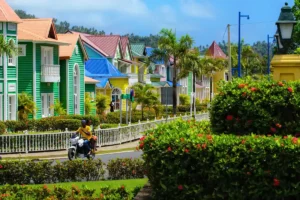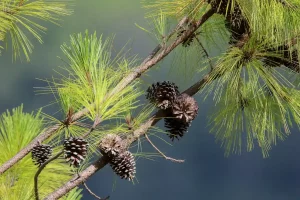Amidst the beautiful Caribbean landscape, the Dominican Republic is home to a unique diversity that captivates nature lovers. Without a doubt, the birds of the Dominican Republic, with their vibrant colors and melodious songs, are an essential part of this rich ecosystem. Their presence offers a fascinating view into the country’s natural wealth. Would you like to explore them in this tropical paradise?
In this article, we’ll tell you about some of the most notable characteristics of these species so that you can experience a world full of life and beauty.
What are the main birds of the Dominican Republic?
Each of the birds of the Dominican Republic has a unique characteristic. Below, we present some of them, which represent the richness and diversity.
Cigua Palmera (Dulus dominicus): the national bird
Among the birds of the Dominican Republic, the Palm Cigua stands out. It is a living symbol of rural life and a pillar of the island’s culture. This species is distinguished by its unique social behavior, as it forms large colonies and builds communal nests in the majestic royal palms.
Their song, a constant and joyful melody, is the soundtrack of fields and cities. Therefore, their presence is unmistakable and evokes a sense of home and tradition.
Their gregarious behavior and the complexity of their nests, which are truly works of social engineering, make them one of the most interesting birds to observe. Furthermore, they reflect a fascinating social structure and exemplary collaboration in nature. Thus, their presence in Dominican landscapes is a constant reminder of the interconnection between fauna and daily life in the country (National Botanical Garden, 2023).
The cotica (Parakeet chloroptera): the Hispaniolan parakeet
If there’s one image that evokes the vibrant spirit of the Caribbean, it’s that of the Cotica. This bright green parakeet is endemic to the island and is one of the most sought-after birds among ornithology enthusiasts. Despite its vulnerable population, it has managed to survive in vitally important protected areas, such as Los Haitises National Park and the Sierra de Bahoruco (Animalia, n.d.a).
Watching a flock of coticas flying through the dense forest foliage is an unforgettable sight. It’s an explosion of color and life that demonstrates the importance of preserving the native animals of the Dominican Republic.
The majestic flamingo (Phoenicopterus ruber): a pink icon
The Caribbean flamingo is one of the most iconic and elegant birds of the Dominican Republic. Not only is it a large and slender bird, but its characteristic pink plumage also makes it a true natural spectacle. In fact, its vibrant color is due to the pigments of the crustaceans and algae it feeds on. Moreover, this impressive bird uses its curved beak as a filter to obtain its food in shallow waters, a fascinating natural process (National Zoological Park, n.d.).
You can often spot them in places of natural beauty, such as Lagoon de Oviedo and Lake Enriquillo. In these locations, the presence of these birds is a vital indicator of the ecosystem’s health. As a result, their majestic presence in these wetlands creates an unforgettable landscape. Without a doubt, it’s a picture of color and life that will remind you of the importance of preserving these unique habitats.
The Española woodpecker (Melanerpes striatus)
The Española woodpecker is one of the most common and easily recognizable birds of the Dominican Republic. This bird is recognized for its distinctive black and white striped plumage, featuring a red crown and nape in males.
Their incessant work on tree trunks is an essential part of the ecosystem. This is because their holes provide shelter for many other species. They are not shy birds, so they are relatively easy to observe in their natural habitat. They can be found in many places, from mountain forests to palm savannas (Animalia, n.d.b.).
Where to find the birds of the Dominican Republic?
The island of Hispaniola is home to an unparalleled array of birdlife, a true treasure trove of biodiversity that distinguishes it as a top destination for ornithology enthusiasts. Of the more than 300 bird species observed, over 30 are endemic, meaning they can only be found in this region (Ministry of Environment and Natural Resources, n.d.). This diversity is a living testament to the island’s geological history, giving rise to an avian fauna you won’t find anywhere else on the planet.
Furthermore, the island has diverse and rich ecosystems. These ecosystems include humid forests in the majestic mountain ranges, vital mangroves in the coastal areas, and the arid regions in the southwest. All these environments create an ideal habitat for birds to develop and thrive.
Exploring this birdlife is more than just a simple observation; it’s an opportunity to connect with a natural legacy that has evolved independently from the rest of the world. At Homebelike, we deeply value this connection. That’s why we design experiences that bring you closer to these natural treasures uniquely and respectfully.
We believe that true luxury lies in being able to immerse yourself in nature, respecting its beauty and fragility. This ensures a profound, immersive, and mindful travel experience that allows you to discover the birds of the Dominican Republic.
Tips for responsible ecotourism with birds of the Dominican Republic
Birdwatching in the Dominican Republicis a form of tourism that allows you to connect deeply with nature. However, it must be done responsibly. For a successful and respectful experience, it’s vital to follow some basic rules. These practices not only protect local wildlife but also enhance the quality of your own observations. This way, you can witness the birds’ natural behavior without interfering.
Birdwatching is a conscious activity; it becomes a valuable tool for environmental education and conservation. This happens because each sighting contributes to the species database, enabling scientists to monitor populations and habitats.
Therefore, your birdwatching adventure is not just a leisure activity, but a valuable contribution to the preservation of ecosystems. And to do it in the best possible way, follow these practical tips.
Respect the distance from birds in their habitat
Avoid getting too close to birds, especially during nesting season. The stress animals face when their habitat is invaded impacts not only their well-being but also that of their youth. Use binoculars to get a close-up view without invading their habitat.
In addition to distance, maintaining silence minimizes stress for animals and allows you to hear them. This is crucial for identifying them. A bird’s song or a mating call is a vital clue that you could miss if you make noise.
Do not use flashes or artificial sounds
These practices can confuse or frighten birds of the Dominican Republic. This, in turn, affects their natural behavior. In the worst cases, it causes them to abandon their nests and young.
Also, recorded sounds can disrupt mating and territoriality patterns, negatively impacting bird populations.
Stay on the trails and have basic equipment
You must stay on marked trails. This way, you avoid damaging the flora or disturbing the habitats of birds and other species. The fragility of specific ecosystems means that even a slight deviation from the norm can have a significant impact.
Basic binoculars and a field guide will also be very helpful. These items will allow you to enjoy birdwatching and learn more about the birds of the Dominican Republic. We also recommend bringing a notebook to record your observations, which will make the experience even more personal and unforgettable.
Visit the official websites
For more information on conservation efforts on the island, we recommend visiting the website of the Dominican Republic’s Ministry of Environment and Natural Resources.
These organizations work tirelessly to protect the island’s ecosystems and its feathered inhabitants. They do this through monitoring programs, environmental education, and the creation of protected areas. By learning about and supporting their work, you become an active participant in preserving the Dominican Republic’s natural wealth, ensuring that future generations can also marvel at the beauty of the birds of the Dominican Republic.
Experience the birds of the Dominican Republic
Ultimately, the Dominican Republic offers an experience beyond expectations. By observing the spectacular birds of the Dominican Republic, you become part of a conservation story and connect with the true natural essence of this paradise. And, at Homebelike, we’re here to ensure your trip is an immersive and mindful experience.
With our experience specialist service, we can organize birdwatching tours to exclusive destinations. We guarantee an adventure that combines luxury and well-being with respect for the environment. We’re not just your average rental; we’re always in touch with you from the moment you book, through to your entire stay. Also, we are attentive to any experiences or services you’d like to book.
If you’re looking for something more personalized, we can create an experience that captures the essence of the country. We utilize our inventory in destinations outside the island’s usual areas and combine them with various attractions to offer you something truly unique. In this way, your trip becomes an opportunity to experience nature in a unique, private, and purposeful way. This way, you’ll also leave a positive mark on the destination you visit.
The peace of mind that comes with knowing everything is carefully planned is priceless. From birdwatching in the Dominican Republicto relaxing in a luxury property, every detail is carefully designed to ensure a worry-free experience. Our goal is for you to immerse yourself in the beauty of the country with a memorable, sustainable, and enriching stay. Therefore, we invite you to discover how exclusivity and responsibility can coexist in an unprecedented travel experience. So, visit our exclusive properties and start planning your adventure here. Explore our ecotourism experiences and experience paradise!
References
- Animalia. (n.d.a.). Cotorra de Hispaniola (Aratinga chloroptera).
- Animalia. (n.d.b.). Pájaro carpintero de Hispaniola (Melanerpes striatus).
- Jardín Botánico Nacional. (2023, January 13). Te compartimos datos sobre la Cigua Palmera (Dulus dominicus).
- Ministerio de Medio Ambiente y Recursos Naturales. (n.d.). Aves endémicas.
- Parque Zoológico Nacional | ZOODOM. (n.d.). Flamenco del Caribe (Phoenicopterus ruber).



